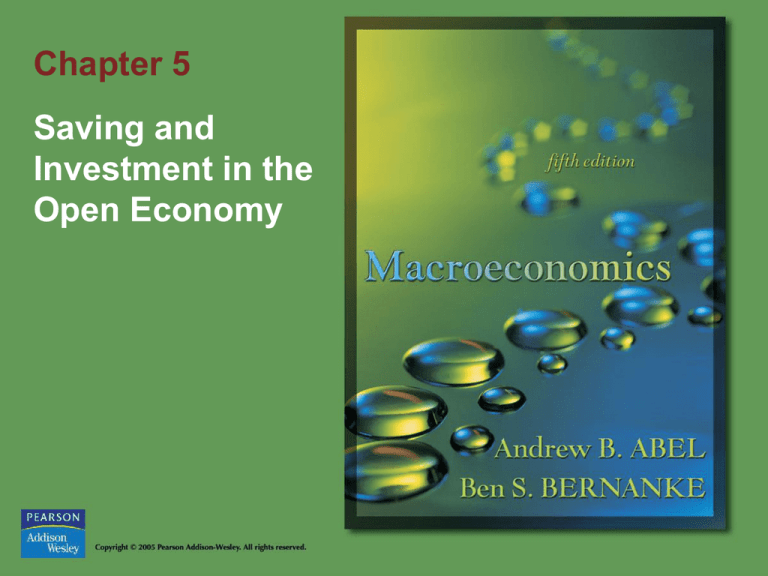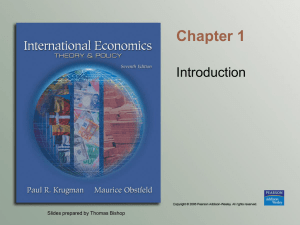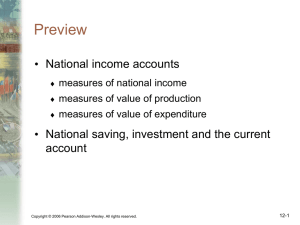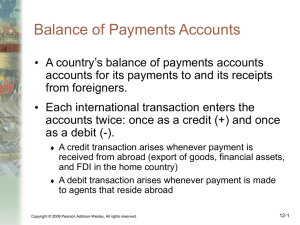
Chapter 5
Saving and
Investment in the
Open Economy
Goals of Chapter 5
Develop the idea that a country's
spending need not equal its production
in every period, due to foreign trade
The fundamental determinants of a
country's trade position are its saving
and investment decisions
Copyright © 2005 Pearson Addison-Wesley. All rights reserved.
5-2
Table 5.1 Balance of Payments Accounts of the
United States, 2002 (Billions of Dollars)
Copyright © 2005 Pearson Addison-Wesley. All rights reserved.
5-3
Table 5.1 Balance of Payments Accounts of the
United States, 2002 (Billions of Dollars) (cont’d)
5-4
5.1 Balance of Payments Accounting
Balance of payments accounts
The record of a country's international transactions
Text Table 5.1 shows recent U.S. data
Any transaction that involves a flow of money into
the United States is a credit (+) item (enters with a
“+” sign); for example, exports
Any transaction involving a flow of money out of the
United States is a debit (-) item (enters with a “-”
sign); for example, imports
In touch with the macroeconomy: the balance of
payments accounts
Data released quarterly in Survey of Current Business
Copyright © 2005 Pearson Addison-Wesley. All rights reserved.
5-5
5.1 Balance of Payments Accounting
The current account
Net exports of goods and services
Merchandise trade: Exports of goods minus imports of goods =
merchandise trade balance
Internationally traded services (transportation, tourism, insurance,
education, financial services) are also important
Net income from abroad
Income received from abroad is a credit item, since it causes
funds to flow into the United States
Payment of income to foreigners is a debit item
Net income from abroad is part of the current account, and is
about equal to NFP, net factor payments
Net unilateral transfers
Payments made from one country to another
Negative net unilateral transfers for United States, since United
States is a net donor to other countries
Sum of net exports of goods and services, net income from
abroad, and net unilateral transfers is the current account
balance
Positive current account balance implies current account surplus
Negative current account balance implies current account deficit
Copyright © 2005 Pearson Addison-Wesley. All rights reserved.
5-6
5.1 Balance of Payments Accounting
The capital and financial account
The capital and financial account records trades in
existing assets, either real (for example, houses)
or financial (for example, stocks and bonds)
The capital account records the net flow of
unilateral transfers of assets into the country
Most transactions appear in the financial account
part of the capital and financial account
When home country sells assets to foreign country, that
is a capital inflow for the home country and a credit (+)
item in the capital and financial account
When assets are purchased from a foreign country, there
is a capital outflow from the home country and a debit (-)
item in the capital and financial account
Copyright © 2005 Pearson Addison-Wesley. All rights reserved.
5-7
5.1 Balance of Payments Accounting
The official settlements balance
Transactions in official reserve assets are conducted by central
banks of countries
Official reserve assets are assets (foreign government
securities, bank deposits, and SDRs of the IMF, gold) used in
making international payments
Central banks buy (or sell) official reserve assets with (or to
obtain) their own currencies
Official settlements balance
Also called the balance of payments, it equals the net increase in
a country's official reserve assets
For the United States, the net increase in official reserve assets is
the rise in U.S. government reserve assets minus foreign central
bank holdings of U.S. dollar assets
Having a balance of payments surplus means a country is
increasing its official reserve assets; a balance of payments
deficit is a reduction in official reserve assets
Copyright © 2005 Pearson Addison-Wesley. All rights reserved.
5-8
5.1 Balance of Payments Accounting
The relationship between the current account
and the capital account
Current account balance (CA) + capital and
financial account balance (KFA) = 0 (5.1)
CA + KFA = 0 by accounting; every
transaction involves offsetting effects
Examples given of offsetting transactions
(Table 5.2)
In practice, measurement problems, recorded
as a statistical discrepancy, prevent CA + KFA
= 0 from holding exactly.
Copyright © 2005 Pearson Addison-Wesley. All rights reserved.
5-9
Table 5.2 Why the Current Account Balance and the
Capital and Financial Account Balance Sum to Zero: An
Example (Balance of Payments Data Refer to the United States)
Copyright © 2005 Pearson Addison-Wesley. All rights reserved.
5-10
5.1 Balance of Payments Accounting
Net foreign assets and the balance of
payments accounts
Net foreign assets are a country's foreign assets
minus its foreign liabilities
Net foreign assets may change in value (example: change
in stock prices)
Net foreign assets may change through acquisition of new
assets or liabilities
The net increase in foreign assets equals a
country's current account surplus
A current account surplus implies a capital and
financial account deficit, and thus a net increase in
holdings of foreign assets (a financial outflow)
Copyright © 2005 Pearson Addison-Wesley. All rights reserved.
5-11
5.1 Balance of Payments Accounting
A current account deficit implies a capital and financial
account surplus, and thus a net decline in holdings of
foreign assets (a financial inflow)
Foreign direct investment: a foreign firm buys or builds
capital goods
Causes an increase in capital and financial account balance
Portfolio investment: foreigners acquire U.S. securities; also
increases capital and financial account balance
Summary: Equivalent measures of a country's
international trade and lending
Current account surplus = capital and financial account deficit
= net acquisition of foreign assets = net foreign lending = (if
NFP and net unilateral transfers are zero) net exports
Copyright © 2005 Pearson Addison-Wesley. All rights reserved.
5-12
5.1 Balance of Payments Accounting
Box 5.1: Does Mars have a current
account surplus?
Adding together all countries' current
account balances gives a current account
deficit for the world
The statistical problem is primarily a
misreporting of income from assets held
abroad
e.g., foreign interest income
Copyright © 2005 Pearson Addison-Wesley. All rights reserved.
5-13
Copyright © 2005 Pearson Addison-Wesley. All rights reserved.
5-14
5.1 Balance of Payments Accounting
Application: The United States as
international debtor
The rise in foreign liabilities by the United
States since the early 1980s has been very
large
The United States has become the world's
largest international debtor
But the net foreign debt of the United States
relative to U.S. GDP is relatively small (18%)
compared to other countries (some of whom
have net foreign debt of over 100% of GDP)
Copyright © 2005 Pearson Addison-Wesley. All rights reserved.
5-15
5.1 Balance of Payments Accounting
Despite the large net foreign debt, the United
States has direct foreign investment (companies,
land) in other countries about equal in size to
other countries' foreign direct investment in the
United States
What really matters is not size of net foreign debt,
but country's wealth (physical and human capital)
If net foreign debt rises but wealth rises, there's no
problem
But U.S. wealth isn't rising as much as net foreign
debt, which is worrisome
Copyright © 2005 Pearson Addison-Wesley. All rights reserved.
5-16
5.2 Goods Market Equilibrium in an Open Economy
From Ch. 2, S = I + CA = I + (NX + NFP) (5.2)
So national saving has two uses:
Increase the capital stock by domestic investment
Increase the stock of net foreign assets by lending to
foreigners
To get goods market equilibrium, national saving
and investment must equal their desired levels:
Sd = Id + CA = Id + (NX + NFP)
(5.3)
Goods market equilibrium in an open economy
Assuming net factor payments are zero, then
Sd = Id + NX
(5.4)
Alternative method:
Y = Cd + Id + G + NX
(5.5)
Net exports equal output (Y) minus absorption (Cd + Id + G) :
NX = Y - (Cd + Id + G) (5.6)
Copyright © 2005 Pearson Addison-Wesley. All rights reserved.
5-17
5.3 Saving and Investment in a Small Open Economy
Small open economy: an economy too small to affect the
world real interest rate
World real interest rate (rw): the real interest rate in the international
capital market
Key assumption: Residents of the small open economy can borrow
or lend at the expected world real interest rate (Key diagram 4; Figs.
5.1 and 5.2)
Result: rw may be such that Sd > Id, Sd = Id, or Sd < Id
If rw = r1, then Sd > Id, so the excess of desired saving over desired
investment is lent internationally (net foreign lending is positive) and
NX > 0
If rw = r2, then Sd = Id, so there is no net foreign lending and NX = 0
If rw = r3, then Sd < Id, so the excess of desired investment over desired
saving is financed by borrowing internationally (net foreign lending is
negative) and NX < 0
Alternative interpretation: in terms of output and absorption
Net exports equals net foreign lending equals the current account
balance (assuming net factor payments and net unilateral transfers
are zero)
Copyright © 2005 Pearson Addison-Wesley. All rights reserved.
5-18
Key Diagram 4 National saving and
investment in a small open economy
Copyright © 2005 Pearson Addison-Wesley. All rights reserved.
5-19
Figure 5.1 A small open economy that
lends abroad
Copyright © 2005 Pearson Addison-Wesley. All rights reserved.
5-20
Figure 5.2 A small open economy that
borrows abroad
Copyright © 2005 Pearson Addison-Wesley. All rights reserved.
5-21
Table 5.3 Goods Market Equilibrium in a Small
Open Economy: An Example (Billions of Dollars)
Copyright © 2005 Pearson Addison-Wesley. All rights reserved.
5-22
5.3 Saving and Investment in a Small Open Economy
The effects of economic shocks in a small open
economy
Anything that increases desired national saving (Y
rises, future output falls, or G falls) relative to desired
investment (MPKf falls, τ rises) at a given world
interest rate increases net foreign lending, and vice
versa
A temporary adverse supply shock
Temporary drop in income leads to a drop in saving, so net
foreign lending declines; shown in Fig. 5.3
An increase in the expected future marginal product
of capital
Desired investment rises, so net foreign lending falls; shown
in Fig. 5.4
Copyright © 2005 Pearson Addison-Wesley. All rights reserved.
5-23
Figure 5.3 A temporary adverse supply
shock in a small open economy
Copyright © 2005 Pearson Addison-Wesley. All rights reserved.
5-24
Figure 5.4 An increase in the expected
future MPK in a small open economy
Copyright © 2005 Pearson Addison-Wesley. All rights reserved.
5-25
5.3 Saving and Investment in a Small Open Economy
Application: The LDC debt crisis
Less developed countries (LDCs) borrowed heavily
from abroad in 1970s
By 1986 their debt exceeded 60% of their GDP
In 1982, bankers lost confidence in LDCs' ability to
repay the loans
Despite the loss of credit, LDCs were mostly able to repay
interest and principal as promised
But the debt repayments exacted a heavy toll, since the LDC's
had to reduce imports and increase exports
As a result, economic growth declined and living standards fell
In 1989, the Brady plan reduced LDC debt in
exchange for economic reforms in LDCs (lower
government spending, increased use of free markets)
Copyright © 2005 Pearson Addison-Wesley. All rights reserved.
5-26
5.3 Saving and Investment in a Small Open Economy
The LDC crisis raises some important questions:
Why did LDCs borrow so much?
LDCs wanted funds for investment
Saving was low because income was low
Also, oil price hikes in the 1970s further reduced income
and saving
The result: LDCs borrowed a lot from other countries
Why did the loans go bad?
The recessions of 1979–1982 reduced demand for LDC
exports
The rise in the world real interest rate in the early 1980s
greatly increased the burden of the debt
Why did the crisis take so long to be resolved?
Solutions to the debt crisis have developed slowly because
of disagreement over how the losses were to be shared
Copyright © 2005 Pearson Addison-Wesley. All rights reserved.
5-27
Figure 5.5 International borrowing in a
developing economy
Copyright © 2005 Pearson Addison-Wesley. All rights reserved.
5-28
5.3 Saving and Investment in a Small Open Economy
Application: the 1994 Mexican crisis
The Mexican economy did poorly in the
1980s
But it had been doing better from 1987 into the
1990s by reducing foreign debt, reducing inflation
and the government deficit, and relying more on
free markets
NAFTA promised to reduce trade barriers with the
United States in 1993
Foreign investors poured money into Mexico
in 1992 and 1993
But the capital account surplus necessitated a current account
deficit
Copyright © 2005 Pearson Addison-Wesley. All rights reserved.
5-29
5.3 Saving and Investment in a Small Open Economy
In 1994, doubts about Mexico's political stability and
questions about the government's willingness to stick
to its reform policies made foreign investors uneasy
Investors began selling off Mexican assets and not renewing
loans
The loss of capital inflows forced Mexico to reduce its current
account deficit
Mexico increased its saving (by cutting consumption) and
reduced investment to reduce the current account deficit
The result was a severe recession
Large capital inflows are a two-edged sword
They help an economy grow more quickly
But sudden withdrawal of foreign funds can be disastrous
Mexico recovered later in the 1990s, however real
GDP per capita was the same in 2002 as it was in 1982
Copyright © 2005 Pearson Addison-Wesley. All rights reserved.
5-30
5.3 Saving and Investment in a Small Open Economy
The political environment: default and
sovereign debt
There is no international agency that can
enforce international debt contracts
But sovereign governments don't often
default on loans, since doing so might
disrupt trade and prevent them from
borrowing in the future
Copyright © 2005 Pearson Addison-Wesley. All rights reserved.
5-31
5.4 Saving and Investment in Large Open Economies
Large open economy: an economy large enough to
affect the world real interest rate
Suppose there are just two economies in the world
The home or domestic economy (saving S, investment I)
The foreign economy, representing the rest of the world (saving
SFor, investment IFor)
The world real interest rate moves to equilibrate desired
international lending by one country with desired international
borrowing by the other (Key diagram 5; Fig. 5.6)
Equivalent statement: The equilibrium world real interest rate
is determined such that a current account surplus in one
country is equal in magnitude to the current account deficit in
the other
Changes in the equilibrium world real interest rate: Any factor
that increases desired international lending of a country
relative to desired international borrowing causes the world
real interest rate to fall
Copyright © 2005 Pearson Addison-Wesley. All rights reserved.
5-32
Key Diagram 5 National saving and
investment in large open economies
Copyright © 2005 Pearson Addison-Wesley. All rights reserved.
5-33
Figure 5.6 The determination of the world real
interest rate with two large open economies
Copyright © 2005 Pearson Addison-Wesley. All rights reserved.
5-34
5.5 Fiscal Policy and the Current Account
Are government budget deficits necessarily
accompanied by current account deficits?
That is, are there "twin deficits"?
The critical factor: the response of national
saving
An increase in the government budget deficit raises
the current account deficit only if the increase in the
budget deficit reduces desired national saving
In a small open economy, if an increase in the
government budget deficit reduces desired national
saving, the saving curve shifts left, thus reducing the
current account balance
Copyright © 2005 Pearson Addison-Wesley. All rights reserved.
5-35
5.5 Fiscal Policy and the Current Account
The government budget deficit and national saving
A deficit caused by increased government purchases
No question here: The deficit definitely reduces national
saving
Result: The current account balance declines
A deficit resulting from a tax cut
Sd falls only if Cd rises
So Sd won't change if Ricardian equivalence holds,
since then a tax cut won't affect consumption
But if people don't foresee the future taxes implied by a
tax cut today, they will consume more, desired saving
will decline, and so will the current account balance
Copyright © 2005 Pearson Addison-Wesley. All rights reserved.
5-36
Figure 5.7 The government budget deficit and
the current account in a small open economy
Copyright © 2005 Pearson Addison-Wesley. All rights reserved.
5-37
5.5 Fiscal Policy and the Current Account
Application: the twin deficits
Relationship between the U.S. government
budget deficit and U.S. current account deficit
Fig. 5.8 shows data
The deficits appear to be twins in the 1980s and
early 1990s, moving closely together
But at other times (during World Wars I and II,
and during 1975) government budget deficits
grew, yet the current account balance increased
The evidence is also mixed for foreign countries
Copyright © 2005 Pearson Addison-Wesley. All rights reserved.
5-38
Figure 5.8 The government budget deficit and the
current account in the United States, 1960–2002
Copyright © 2005 Pearson Addison-Wesley. All rights reserved.
5-39







